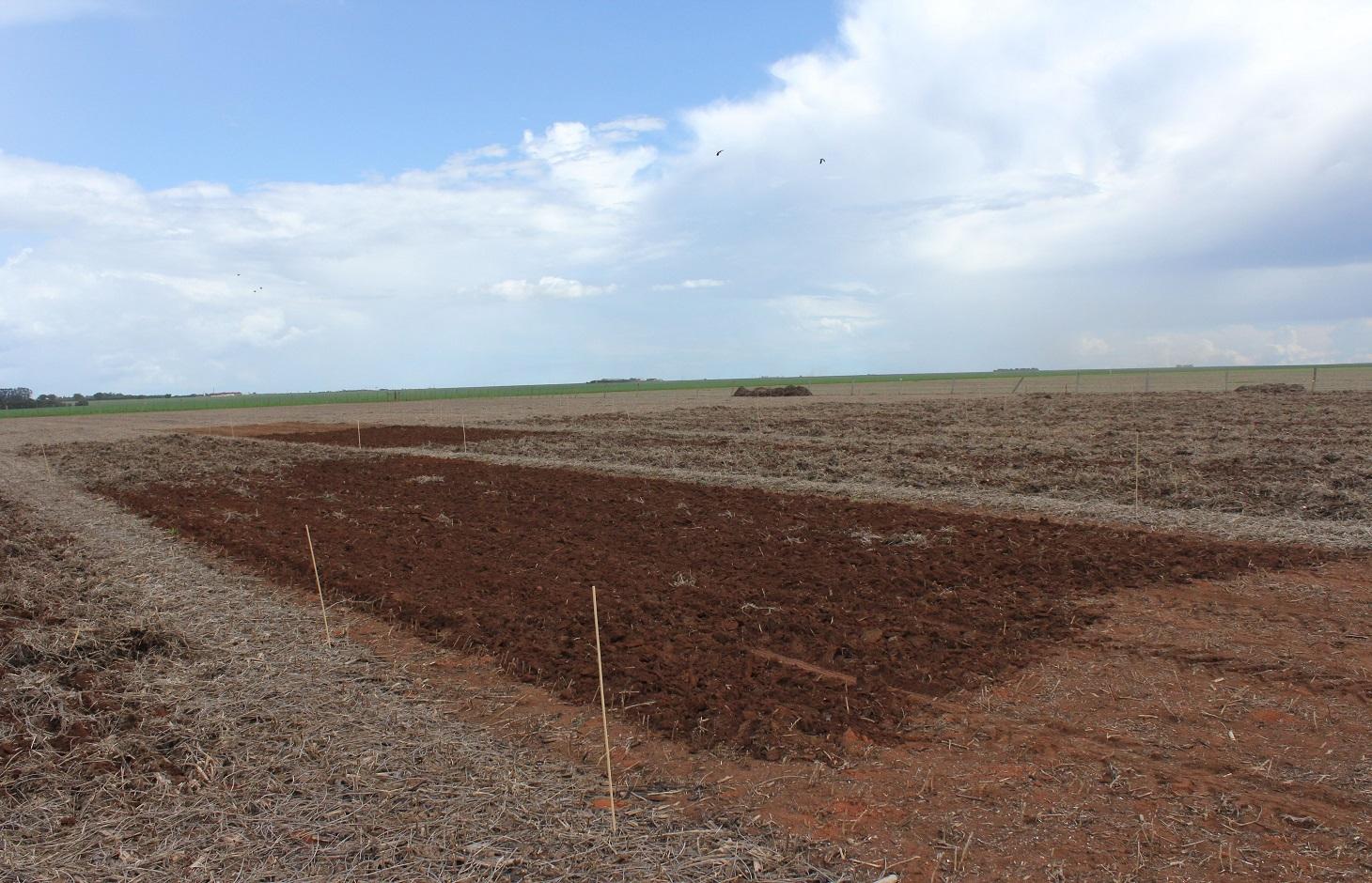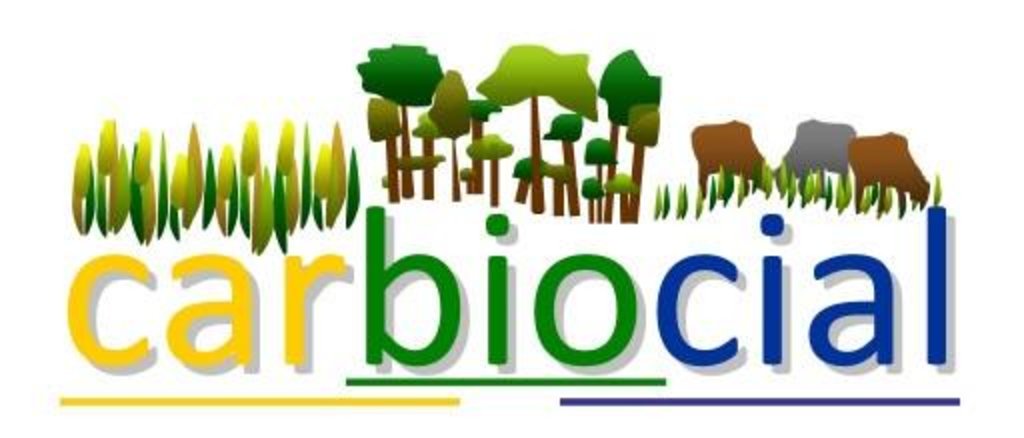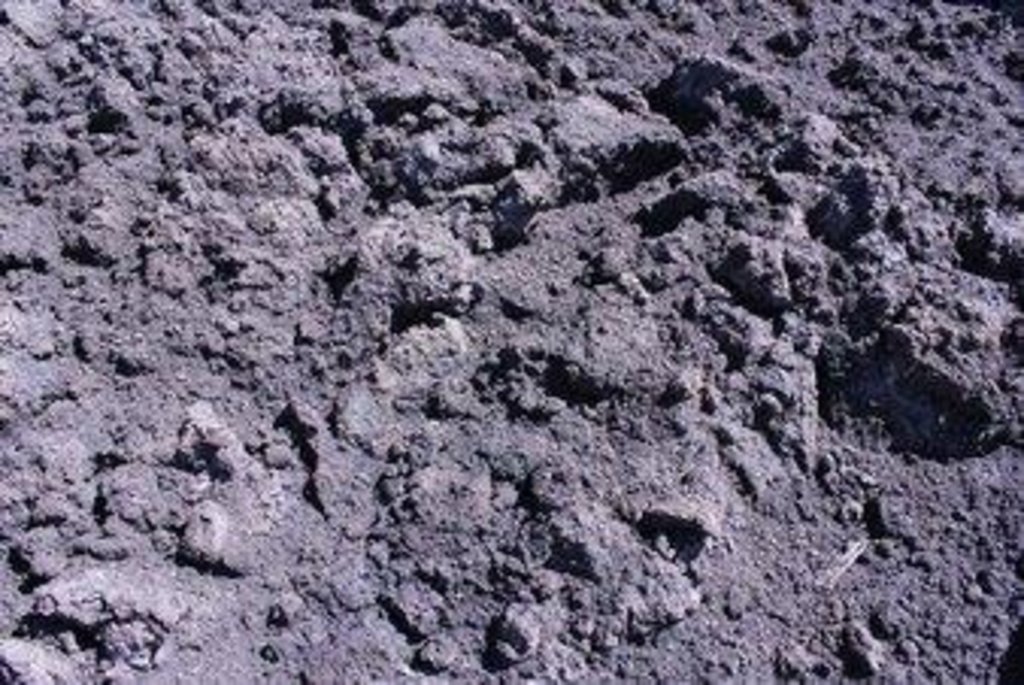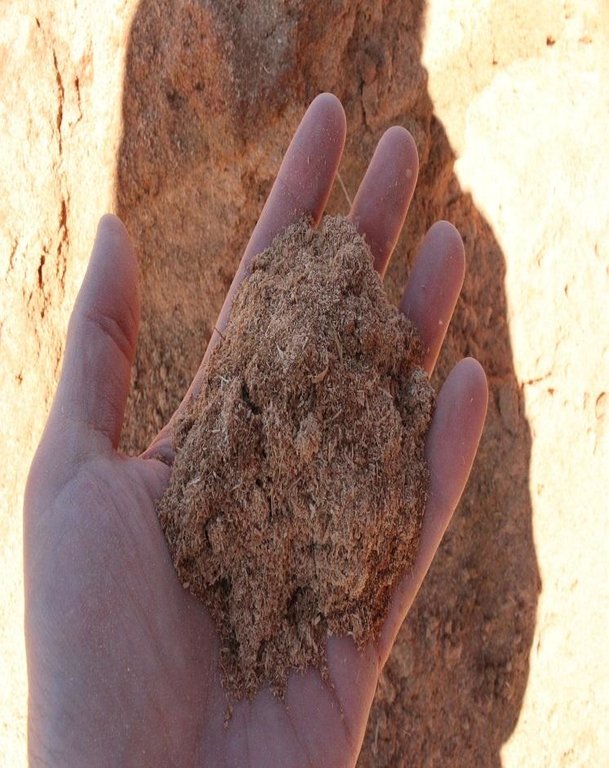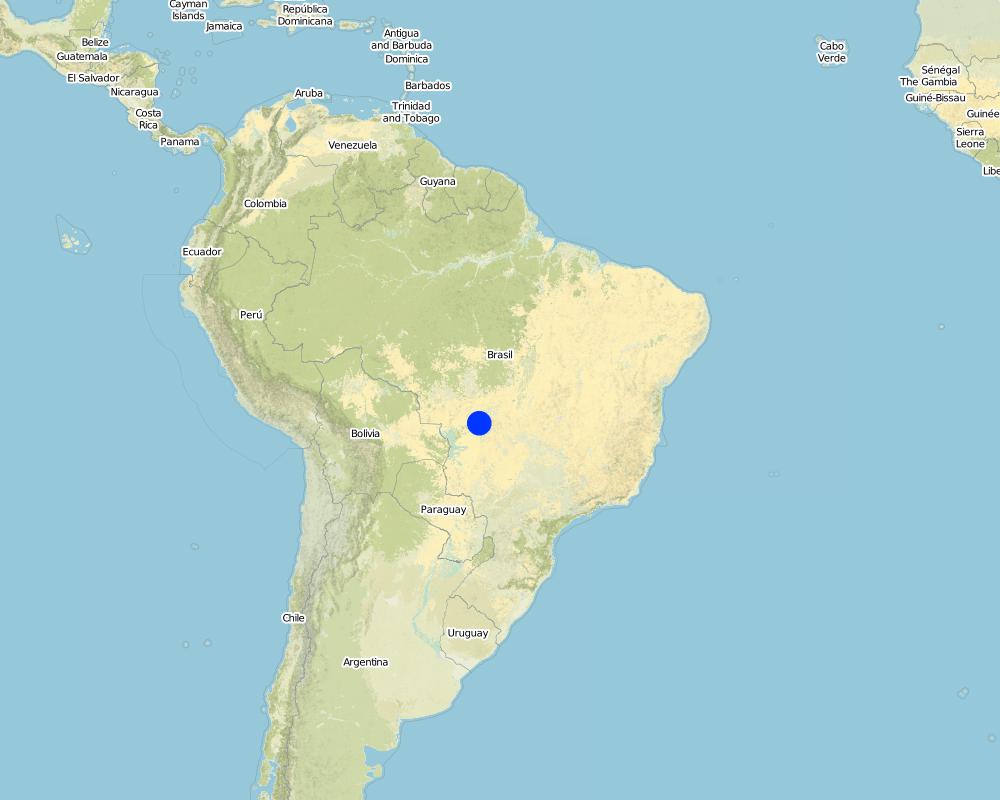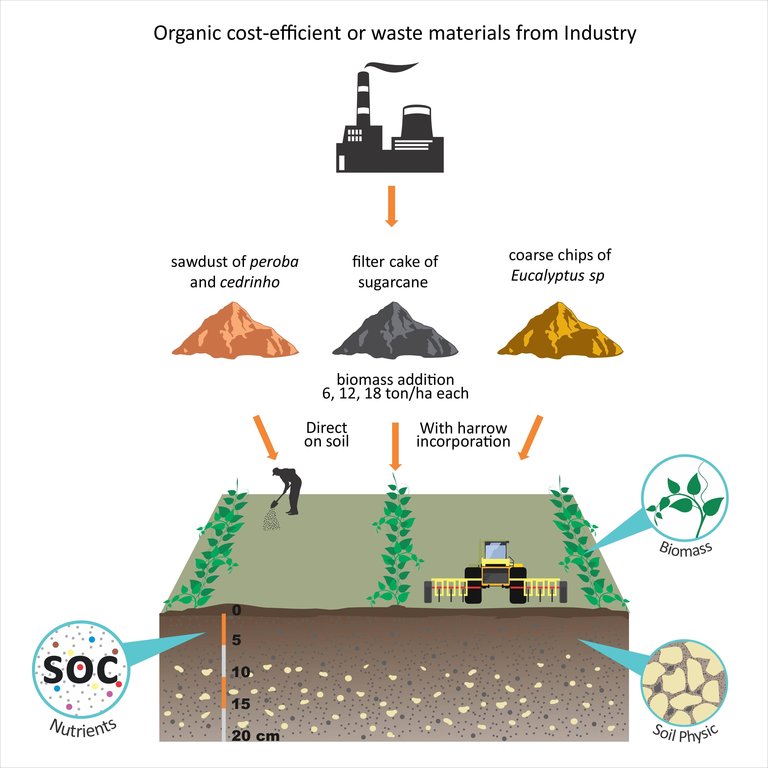Carbon-enrichment of tropical agricultural soil with organic matter [Brazil]
- Creation:
- Update:
- Compiler: Luisa F. Vega
- Editor: –
- Reviewers: Alexandra Gavilano, Deborah Niggli, David Streiff
Enriquecimento de carbono em solo de lavoura com matéria orgânica (Brazil)
technologies_1250 - Brazil
- Full summary as PDF
- Full summary as PDF for print
- Full summary in the browser
- Full summary (unformatted)
- Carbon-enrichment of tropical agricultural soil with organic matter: Jan. 5, 2017 (inactive)
- Carbon-enrichment of tropical agricultural soil with organic matter: Maart 7, 2017 (inactive)
- Carbon-enrichment of tropical agricultural soil with organic matter: April 29, 2017 (inactive)
- Carbon-enrichment of tropical agricultural soil with organic matter: Maart 7, 2019 (public)
View sections
Expand all Collapse all1. General information
1.2 Contact details of resource persons and institutions involved in the assessment and documentation of the Technology
SLM specialist:
Irmler Prof. Dr. Ulrich
Institute for Ecosystem Research
Germany
SLM specialist:
Wantzen Prof. Dr. Karl M.
CNRS UMR CITERES
France
Name of project which facilitated the documentation/ evaluation of the Technology (if relevant)
Book project: Making sense of research for sustainable land management (GLUES)Name of project which facilitated the documentation/ evaluation of the Technology (if relevant)
Carbon optimized land management strategies for southern Amazonia (CARBIOCIAL / GLUES)Name of the institution(s) which facilitated the documentation/ evaluation of the Technology (if relevant)
University of Kiel (University of Kiel) - GermanyName of the institution(s) which facilitated the documentation/ evaluation of the Technology (if relevant)
Universidade Federal de Mato Grosso (Universidade Federal de Mato Grosso) - BrazilName of the institution(s) which facilitated the documentation/ evaluation of the Technology (if relevant)
Université Francois-Rabelais de Tours (Université Francois-Rabelais de Tours) - France1.3 Conditions regarding the use of data documented through WOCAT
The compiler and key resource person(s) accept the conditions regarding the use of data documented through WOCAT:
Ja
1.4 Declaration on sustainability of the described Technology
Is the Technology described here problematic with regard to land degradation, so that it cannot be declared a sustainable land management technology?
Nee
1.5 Reference to Questionnaire(s) on SLM Approaches (documented using WOCAT)
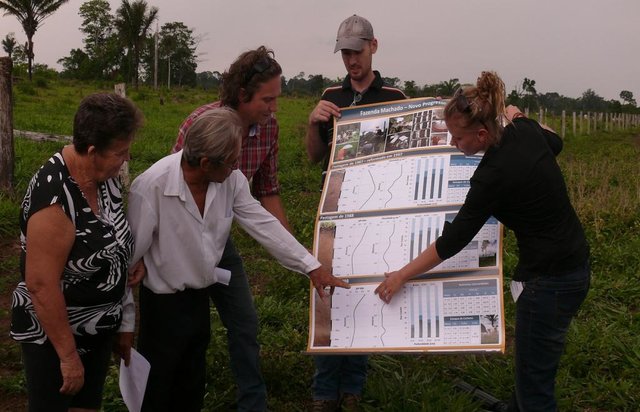
From storylines to scenarios: raising awareness and decision … [Brazil]
Investigating viable carbon-optimized land management strategies, which maintain or improve ecosystem function, under changing climate conditions in the Southern Amazon - using regional scenarios generated from storylines.
- Compiler: Jan Goepel
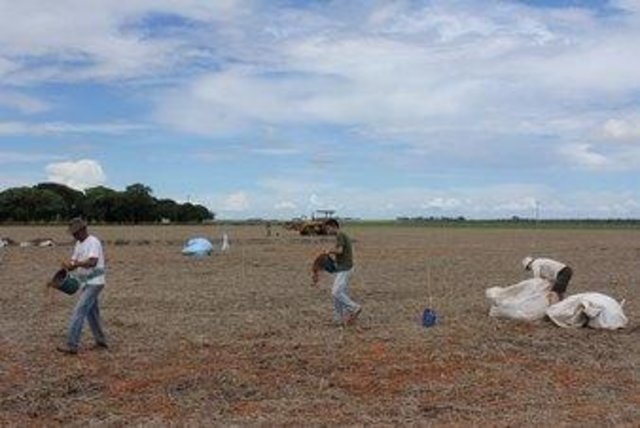
Enrichment of Tropical Agricultural Soil with Organic Matter [Brazil]
Enrichment of tropical agicultural soils with local available organic matter in the cerrado agroscape, Brazil.
- Compiler: Luisa F. Vega
2. Description of the SLM Technology
2.1 Short description of the Technology
Definition of the Technology:
Carbon-enrichment of tropical agricultural soils with locally available organic matter in the Cerrado agricultural landscape, Brazil.
2.2 Detailed description of the Technology
Description:
In the Carbiocial Project viable land management strategies were explored to optimize the level of carbon in soil and water, helping to maintain and/or improve ecosystem functions, under changing climatic conditions in the Southern Amazon and the Brazilian Cerrado. In the framework of this project, on-farm experiments were performed to enrich tropical agricultural soils in the medium term, with different types of organic matter (OM). In the experiment the effect of different types of OM amendments on soil carbon and macro-nutrients (N, P, and K), soil physical properties (waterholding capacity) and crop yield (soy biomass and grain production) were assessed. The amendments applied are locally available, and are either free (being waste materials) or considered cost-efficient.
The objective of this on-going experiment is to compare the impact of (i) the quality and quantity of OM applied, (ii) and the application methods (directly on the soil surface or incorporation by harrow) on soil chemical and physical properties. It is hypothesised that the addition of OM can enhance crop yields and, potentially, soil biodiversity. The effects of the different OM types, amounts and application methods were evaluated after one, two and three years. From the results, the aim is to provide recommendations for the development of soil OM-enrichment schemes and carbon-friendly landscape management programs for farmers, using local resources.
The experiment was established on an area of about one hectare on a ferrasol (red latosol) at the Rio Engano Farm, in the municipality of Campo Verde, Mato Grosso State. The farm has a total area of ca. 1500 ha, 830 ha of which are cultivated with soybean and maize rotation, under a zero-tillage system, which is typical of many farms in this region. It is located in the Brazilian Cerrado (savanna) biome at about 685 m a.s.l. This biome covers 2 million km2, which is 23% of the country area. It has a semi-humid climate with a pronounced dry season. The precipitation during the rainy season (September-April) varies between 800 and 2000 mm/year.
At the beginning of the experiment (February 2012), three different types of OM amendments were applied. They comprised (a) sugarcane filter cake (Saccharum officinarum from ethanol/sugar-production, (b) sawdust of peroba and cedrinho (Peroba jaune and Erisma uncinatum, respectively) and (c) coarse chips of Eucalyptus sp. Quantities applied were 0 (control), 6, 12 and 18 tonnes of each per hectare; using two methods: directly on the soil surface, and incorporated by harrow. There were three repetitions per treatment. The area was not fenced to allow the farmers to continue with their field routines on all plots. In February 2013, 2014 and 2015 soil samples were taken to analyze their chemical and physical properties. Soybean samples were also taken in February 2014 and 2015 to estimate biomass and grain production. From the initial results some conclusions can be drawn: 1) Organic amendment addition to ferrasols can significantly increase soil organic carbon, even in amounts as low as 6 t/ha. 2) Amendments should be reapplied every 2 years. 3) The amendment type and application method does not have a significant effect on increasing soil organic carbon. 4) The addition of OM amendments is a win-win situation as a solution for organic matter waste recycling, and simultaneously to improve soil quality.
The area was not fenced to allow the farmer to continue with their arable field routines on all treatment plots. In February 2013, 2014 and 2015 soil samples were taken to analyze their chemical and physical properties. Soy bean samples were also taken in February 2014 and 2015 to estimate biomass and grain production.
From our first results we can draw some conclusions:
1) Organic amendment addition to Ferrasol can increase significantly soil organic carbon (SOC) percentage, even in small amounts such as 6 ton/ha.
2) Amendment reapplication should be done in 2 years intervals.
3) The amendment type and disposition did not have a significant effect on increasing SOC.
4) The addition of OM amendments is a win-win situation as a solution for organic matter waste recycling and to improve soil quality.
2.3 Photos of the Technology
2.5 Country/ region/ locations where the Technology has been applied and which are covered by this assessment
Country:
Brazil
Region/ State/ Province:
Mato Grosso
Further specification of location:
Campo Verde
Specify the spread of the Technology:
- evenly spread over an area
If the Technology is evenly spread over an area, specify area covered (in km2):
0.011544
Comments:
Total area covered by the SLM Technology is 0.011544 km2.
In the São Valentim Farm, located in the Brazilian Cerrado (savanna) biome. The experimental soil enrichment was established in February 2012, on a Ferrasol. The area was under a soybean-corn crop rotation
Map
×2.6 Date of implementation
If precise year is not known, indicate approximate date:
- less than 10 years ago (recently)
2.7 Introduction of the Technology
Specify how the Technology was introduced:
- during experiments/ research
- through projects/ external interventions
Comments (type of project, etc.):
The enrichment of the soil by OM application is a traditional practice. Some of the added OM types in this experimet are already used in the Cerrado without any technical specification. This project aim to identify of one or more types, amounts and application methods of OM, which improve significantly soil quality and carbon stock. The OM effects are evaluated after 2 and 3 years of its addition, which was initially done in February 2012.
3. Classification of the SLM Technology
3.1 Main purpose(s) of the Technology
- improve production
- conserve ecosystem
3.2 Current land use type(s) where the Technology is applied
Land use mixed within the same land unit:
Ja
Specify mixed land use (crops/ grazing/ trees):
- Agro-pastoralism (incl. integrated crop-livestock)

Cropland
- Annual cropping
Number of growing seasons per year:
- 2
Specify:
Longest growing period in days: 150, Longest growing period from month to month: November to March; Second longest growing period in days: 120, Second longest growing period from month to month: April to July

Grazing land
Extensive grazing:
- Ranching
Intensive grazing/ fodder production:
- Cut-and-carry/ zero grazing
Comments:
Major land use problems (compiler’s opinion): Croplands demonstrate a reduction in soil organic matter, after their conversion from indigenous vegetation into agricultural fields. It is especially critical in the ferrasol soils of the Brazilian Cerrado, as its organic matter content is relatively low, and tropical temperatures and humidity accelerate microbial activity (Price and Sowers 2004)
Major land use problems (land users’ perception): There are also problems regarding soil compaction and rainfall regime change
Grazingland comments: There is some grazing by tapir, capibara, wild pig, ema, papagay
Type of grazing system comments: There is some grazing by tapir, capibara, wild pig, ema, papagay
Livestock density: > 100 LU /km2
3.4 Water supply
Water supply for the land on which the Technology is applied:
- rainfed
3.5 SLM group to which the Technology belongs
- integrated soil fertility management
3.6 SLM measures comprising the Technology

agronomic measures
- A2: Organic matter/ soil fertility
- A3: Soil surface treatment
- A4: Subsurface treatment
Comments:
Type of agronomic measures: manure / compost / residues, zero tillage / no-till, non-inversion tillage
3.7 Main types of land degradation addressed by the Technology

soil erosion by water
- Wt: loss of topsoil/ surface erosion

chemical soil deterioration
- Cn: fertility decline and reduced organic matter content (not caused by erosion)

physical soil deterioration
- Pc: compaction

biological degradation
- Bs: quality and species composition/ diversity decline
Comments:
Main causes of degradation: soil management (Extensive areas of monoculture), crop management (annual, perennial, tree/shrub) (Intensive soil use), deforestation / removal of natural vegetation (incl. forest fires) (In the region, the native vegetation of Cerrado was deforested during the early 80´s for agricultural purposes.), population pressure (Most of the agricultural production from The Brazilian Cerrado meet the food demand from Europe and China)
Secondary causes of degradation: Heavy / extreme rainfall (intensity/amounts) (There is an increase of extreme rainfall events which take place during the rainy season), labour availability (Reduction of availability of skilled labor for instance, to carry out integral monitoring of plagues), education, access to knowledge and support services (There a positive relationship between education level of farmers and the adoption of new technologies for sustainable land management), governance / institutional (Part of the colonization and conversion of the Brazilian Cerrado into agricultural systems was encouraged by Research (Embrapa) and Financing Government Programs)
3.8 Prevention, reduction, or restoration of land degradation
Specify the goal of the Technology with regard to land degradation:
- reduce land degradation
4. Technical specifications, implementation activities, inputs, and costs
4.1 Technical drawing of the Technology
Technical specifications (related to technical drawing):
Enrichment of Tropical agricultural soil (Ferrasol) with organic matter amendments. Experimental design: amendment types, amounts and disposition methods (direct on the soil or with harrow incorporation). Studied variables: soil carbon and nutrients, soil physical properties (water holding capacity) and crop yield (soy biomass and grain production).
Location: Rio Engano Ranch. Campo Verde / Mato Grosso / Brazil
Date: 6.11.2015
Technical knowledge required for field staff / advisors: low
Technical knowledge required for land users: low
Main technical functions: increase in organic matter, increase / maintain water stored in soil
Secondary technical functions: control of raindrop splash, control of dispersed runoff: impede / retard, improvement of topsoil structure (compaction), stabilisation of soil (eg by tree roots against land slides), increase in nutrient availability (supply, recycling,…), increase of infiltration, increase of groundwater level / recharge of groundwater, water harvesting / increase water supply
Manure / compost / residues
Material/ species: (a) Filter cake of sugarcane residues (Saccharum officinarum from alcohol/sugar-production, (b) saw
Quantity/ density: 6, 12, 18
Zero tillage / no-till
Remarks: A part of the organic matter was added directly on the soil surface
Non-inversion tillage
Remarks: Another part of the organic matter was incorporate into the soil by using harrow
Author:
Diego Orduz, orduzrobles@gmail.com
4.2 General information regarding the calculation of inputs and costs
other/ national currency (specify):
BRL
If relevant, indicate exchange rate from USD to local currency (e.g. 1 USD = 79.9 Brazilian Real): 1 USD =:
4.0
Indicate average wage cost of hired labour per day:
25.00
4.4 Costs and inputs needed for establishment
Comments:
Duration of establishment phase: 0 month(s)
4.5 Maintenance/ recurrent activities
| Activity | Timing/ frequency | |
|---|---|---|
| 1. | 1.Transport of amendments by trucks (0.2 tonne/US$) | |
| 2. | 2.Spreading / incorporation of organic matter by tractor (US$ 3/ha for petrol and US$ 5/ha for tractor driver). |
4.6 Costs and inputs needed for maintenance/ recurrent activities (per year)
| Specify input | Unit | Quantity | Costs per Unit | Total costs per input | % of costs borne by land users | |
|---|---|---|---|---|---|---|
| Labour | labour | ha | 1.0 | 5.0 | 5.0 | 100.0 |
| Equipment | machine use | ha | 1.0 | 15.0 | 15.0 | 100.0 |
| Equipment | truck transport | ha | 1.0 | 150.0 | 150.0 | 100.0 |
| Total costs for maintenance of the Technology | 170.0 | |||||
| Total costs for maintenance of the Technology in USD | 42.5 | |||||
4.7 Most important factors affecting the costs
Describe the most determinate factors affecting the costs:
Amendment truck transport (0,2 ton/US$), amendment application by tractor(15 US$*ha/dia)
and tractor driver (5 US$*ha) costs.
The used organic matter amendments are cost-free. It is suggested to use cost-free materials if possible or cost–efficient materials to reduce implementation and maintenance costs. Transport of amendments is paid by tonne, independently of the type. The OM application methods (direct on the soil by hand or with harrow incorporation) did not show significant differences. For this reason only the costs for the tractor were calculated, because it is a more economic option.
5. Natural and human environment
5.1 Climate
Annual rainfall
- < 250 mm
- 251-500 mm
- 501-750 mm
- 751-1,000 mm
- 1,001-1,500 mm
- 1,501-2,000 mm
- 2,001-3,000 mm
- 3,001-4,000 mm
- > 4,000 mm
Specifications/ comments on rainfall:
The area presents strong seasonality: dry season (May-Sep) and rainy season (Oct-Apr)
Agro-climatic zone
- sub-humid
Thermal climate class: tropics
5.2 Topography
Slopes on average:
- flat (0-2%)
- gentle (3-5%)
- moderate (6-10%)
- rolling (11-15%)
- hilly (16-30%)
- steep (31-60%)
- very steep (>60%)
Landforms:
- plateau/plains
- ridges
- mountain slopes
- hill slopes
- footslopes
- valley floors
Altitudinal zone:
- 0-100 m a.s.l.
- 101-500 m a.s.l.
- 501-1,000 m a.s.l.
- 1,001-1,500 m a.s.l.
- 1,501-2,000 m a.s.l.
- 2,001-2,500 m a.s.l.
- 2,501-3,000 m a.s.l.
- 3,001-4,000 m a.s.l.
- > 4,000 m a.s.l.
5.3 Soils
Soil depth on average:
- very shallow (0-20 cm)
- shallow (21-50 cm)
- moderately deep (51-80 cm)
- deep (81-120 cm)
- very deep (> 120 cm)
Soil texture (topsoil):
- fine/ heavy (clay)
Topsoil organic matter:
- high (>3%)
5.4 Water availability and quality
Ground water table:
5-50 m
Availability of surface water:
good
Water quality (untreated):
for agricultural use only (irrigation)
5.5 Biodiversity
Species diversity:
- low
5.6 Characteristics of land users applying the Technology
Market orientation of production system:
- commercial/ market
Off-farm income:
- less than 10% of all income
Relative level of wealth:
- average
- rich
Individuals or groups:
- individual/ household
Level of mechanization:
- mechanized/ motorized
Gender:
- men
Indicate other relevant characteristics of the land users:
Land users applying the Technology are mainly common / average land users
Difference in the involvement of women and men: In the Cerrado most of the extensive crops (soy bean, corn and cotton) are managed by men
Population density: < 10 persons/km2
Annual population growth: > 4%; 7%
3% of the land users are very rich.
46% of the land users are rich.
51% of the land users are average wealthy.
Off-farm income specification: The off-farm income in the Cerrado is in most cases not relevant for farmers, both applying or not conservation meaures. Their income depent principally on agricultural activities such as soy bean, corn and cotton crops among others.
5.7 Average area of land used by land users applying the Technology
- < 0.5 ha
- 0.5-1 ha
- 1-2 ha
- 2-5 ha
- 5-15 ha
- 15-50 ha
- 50-100 ha
- 100-500 ha
- 500-1,000 ha
- 1,000-10,000 ha
- > 10,000 ha
Is this considered small-, medium- or large-scale (referring to local context)?
- small-scale
5.8 Land ownership, land use rights, and water use rights
Land ownership:
- individual, titled
Land use rights:
- individual
Water use rights:
- leased
Comments:
The water used is regulated by the Environmental Secretary of the State (SEMA). Thus, water users have to obtain an Environmental License, where the volumen of water consumption is declared. The license is free of charge.
5.9 Access to services and infrastructure
health:
- poor
- moderate
- good
education:
- poor
- moderate
- good
technical assistance:
- poor
- moderate
- good
employment (e.g. off-farm):
- poor
- moderate
- good
markets:
- poor
- moderate
- good
energy:
- poor
- moderate
- good
roads and transport:
- poor
- moderate
- good
drinking water and sanitation:
- poor
- moderate
- good
financial services:
- poor
- moderate
- good
6. Impacts and concluding statements
6.1 On-site impacts the Technology has shown
Socio-economic impacts
Production
crop production
risk of production failure
land management
Comments/ specify:
There is not specific machinery for organic matter application in large scale
Water availability and quality
demand for irrigation water
Income and costs
expenses on agricultural inputs
farm income
Comments/ specify:
In case the technology reduces the crop demand for chemical fertilization, nonetheless this effect has not been yet evaluated
Other socio-economic impacts
It provides a better environmental and technical use for agroindustrial residues
costs of transport and application of OM amendments
Socio-cultural impacts
conflict mitigation
Ecological impacts
Soil
soil moisture
nutrient cycling/ recharge
soil organic matter/ below ground C
Biodiversity: vegetation, animals
biomass/ above ground C
Other ecological impacts
increased soil micro-organisms and fauna
6.3 Exposure and sensitivity of the Technology to gradual climate change and climate-related extremes/ disasters (as perceived by land users)
Gradual climate change
Gradual climate change
| Season | increase or decrease | How does the Technology cope with it? | |
|---|---|---|---|
| annual temperature | increase | not well |
Climate-related extremes (disasters)
Meteorological disasters
| How does the Technology cope with it? | |
|---|---|
| local rainstorm | well |
| local windstorm | well |
Climatological disasters
| How does the Technology cope with it? | |
|---|---|
| drought | not well |
Hydrological disasters
| How does the Technology cope with it? | |
|---|---|
| general (river) flood | not well |
Other climate-related consequences
Other climate-related consequences
| How does the Technology cope with it? | |
|---|---|
| reduced growing period | not well |
6.4 Cost-benefit analysis
How do the benefits compare with the establishment costs (from land users’ perspective)?
Short-term returns:
slightly negative
Long-term returns:
positive
How do the benefits compare with the maintenance/ recurrent costs (from land users' perspective)?
Short-term returns:
slightly negative
Long-term returns:
positive
Comments:
The technology cost of maintenance is the same as establishment cost. According with our results, amendment reapplication should be done in 2 years intervals, starting from small amounts such as 6 ton/ha.
6.5 Adoption of the Technology
Comments:
There is no trend towards spontaneous adoption of the Technology
Antonio Huebner, land owner and user of the Rio Engano Farm is aware of the technology benefits for soil fertility. However, he considers that OM costs of transport and application can hinder the technology incorporation into common practice for soil management.
6.7 Strengths/ advantages/ opportunities of the Technology
| Strengths/ advantages/ opportunities in the compiler’s or other key resource person’s view |
|---|
| The addition of industrial organic matter (OM) waste from levels of only 6 tonnes/ha onwards can significantly increase soil organic carbon on a ferrasol in the Brazilian Cerrado. This increase took place regardless of the type of OM waste applied and even when the soil was under no-tillage for more than 20 years |
6.8 Weaknesses/ disadvantages/ risks of the Technology and ways of overcoming them
| Weaknesses/ disadvantages/ risks in the land user’s view | How can they be overcome? |
|---|---|
| The costs of transport and application can hinder the extensive use of soil OM enrichment practices among land users in the Brazilian Cerrado | Subsidies could encourage the technology adoption. |
| There is no specific machinery for OM spreading / incorporation, which increases human workload | To reduce human labour, it is recommended to design / adapt machinery for this purpose (e.g. of lime or mulch application machinery). However, more tests and improvements of the application methods are desirable. |
| Materials used as OM amendments could be toxic and pose a risk of soil pollution | It is important that land users are well informed about the risks. Crude forest material such as sawdust from peroba and cedrinho or roughly processed material such as filter cake of sugarcane used in this study should not have a toxic effect. Regarding the potential allelopathic effect of eucalyptus, its decomposing biomass does not seem to have a significant inhibitory effect on other crops (Chu et al. 2014) |
7. References and links
7.1 Methods/ sources of information
- field visits, field surveys
- interviews with land users
7.2 References to available publications
Title, author, year, ISBN:
Price PB, Sowers T (2004) Temperature dependence of metabolic rates for microbial growth, maintenance, and survival.
Available from where? Costs?
Proceedings of the National Academy of Sciences of the United States of America 101:4631-4636
Title, author, year, ISBN:
Tivet F et al. (2013) Aggregate C depletion by plowing and its restoration by diverse biomass-C inputs under no-till in sub-tropical and tropical regions of Brazil.
Available from where? Costs?
Soil and tillage research, 126 :203-218
Title, author, year, ISBN:
Zech W. et al. (1997) Factors controlling humific G. ation and Mineralization of soil organic matter in the tropics.
Available from where? Costs?
Geoderma 79 : 117-161
Title, author, year, ISBN:
Chu, C. et al. (2014) Allelopathic effects of Eucalyptus on native and introduced tree species
Available from where? Costs?
Forest Ecology and Management, Volume 323: 79-84
Links and modules
Expand all Collapse allLinks

From storylines to scenarios: raising awareness and decision … [Brazil]
Investigating viable carbon-optimized land management strategies, which maintain or improve ecosystem function, under changing climate conditions in the Southern Amazon - using regional scenarios generated from storylines.
- Compiler: Jan Goepel

Enrichment of Tropical Agricultural Soil with Organic Matter [Brazil]
Enrichment of tropical agicultural soils with local available organic matter in the cerrado agroscape, Brazil.
- Compiler: Luisa F. Vega
Modules
No modules


